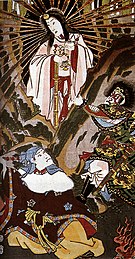User:Immanuelle/Hinumanai Shrine
| This user page or section is currently being expanded by an editor. You are welcome to help in expanding too. If this page has not been changed in several days, please remove this template. This page was last edited by Immanuelle (talk | contribs) 7 months ago. |
| This is a draft being worked on by Immanuelle. It may be too complex at the moment but she wants to get it ready to be an article someday. Others are free to edit it This page was last edited by Immanuelle (talk | contribs) 7 months ago. |
| Immanuelle/Hinumanai Shrine | |
|---|---|
比沼麻奈為神社 | |
 | |
| Religion | |
| Affiliation | Shinto |
| Deity | Toyouke-hime |
| Festival | September 15th |
| Location | |
| Geographic coordinates | 35°35′33.3″N 135°01′44.3″E / 35.592583°N 135.028972°E |
| The English used in this user page may not be easy for everybody to understand. You can help Wikipedia by reading Wikipedia:How to write Simple English pages, then simplifying the page. |
Hinumanai Shrine (比沼麻奈為神社) is a shrine to Toyoukebime in Kyōtango.[1][2] It is not strictly speaking a Moto-Ise Shrine but it is a Moto-Geku shrine, this is to say Toyoukehime came to Earth in this shrine[2][3], and then moved to Kono Shrine and eventually got to Geku[3].
The Hinumanai Shrine (比沼麻奈為神社) is mentioned in Engishiki dating back to Heian period, as Taniwa (田庭) literally meaning the Garden of Rice Paddies. That ancient place name is thought to have changed over time to Taba (location of rice paddies), then to Tamba/Tanba (丹波).[4]
Nearby there is a well Seisuido (清水戸) and a story of the now lost half-moon-shaped rice paddy Tsukinowa den (月の輪田). They are believed to be the site where Toyouke had soaked rice seeds to encourage germination and planted the first rice.[4][3]
However unfortunately due to the Shrine Consolidation Policy the original Tsukinowa den was likely destroyed.[3]
It venerates the deity Toyoke no Kami and is located at the foot of Mount Kujigatake.[2]
Overview
[change | change source]To reach Hinumanai Shrine visitors follow a road that leads to its torii gate. Next to this entrance stands a group of stones guiding guests to a section within the shrine grounds. Interestingly there is no priest (guji san) at Hinumanai Shrine.[2]
The shrines layout features a torii gate at the foot of a staircase that meanders into an area and ultimately arrives at the haiden or worship hall. Positioned close, to the haiden is the Honden dedicated to Toyoke no Kami—a deity associated with agriculture and prosperity. A special monument honoring Toyoke no Kami stands on the side of the honden haiden complex.[2]
Visitors are advised against venturing beyond the keidai (shrine precincts) or climbing Mount Kujigatake to maintain the sanctity of this revered site.[2]
There have been discussions regarding the whereabouts of Toyoke Omikami's tomb. Access, to locations near the shrine is off limits.[2]
As visitors depart from the shrine they may observe papers fluttering on the rope of the torii gate adding to the tranquil ambiance of the shrine. While visitors are encouraged to show respect and reflect in silence certain paths and areas within its spiritual surroundings are restricted for exploration.[2]
Gallery
[change | change source]-
Haiden (Worship Hall) of Hinumanai-jinja
-
Honden (Main Shrine) of Hinumanai-jinja
-
Keidaisha (Auxiliary Shrine) of Hinumanai-jinja
-
Sandou (Approach) to Hinumanai-jinja
-
Shaden of Hinumanai-jinja
-
Shaden of Hinumanai-jinja (alternate view)
-
Torii (Shrine Gate) of Hinumanai-jinja
-
Torii (Shrine Gate) of Hinumanai-jinja in Kyoto Tango City
References
[change | change source]- ↑ "Dragons, Demons and Deities: Folklore of the Kyoto by the Sea Area | Inspiration". Another Kyoto Official Travel Guide. Retrieved 2023-10-03.
- ↑ 2.0 2.1 2.2 2.3 2.4 2.5 2.6 2.7 Okunomichi (2017-08-06). "Tamba no Kuni: Hinumanai Jinja". Yama no Miya. Retrieved 2024-03-29.
- ↑ 3.0 3.1 3.2 3.3 "Dragons, Demons and Deities: Folklore of the Kyoto by the Sea Area | Inspiration". Another Kyoto Official Travel Guide. Retrieved 2024-03-29.
- ↑ 4.0 4.1 Sankei Digital Inc. (2014-10-21). "Inasaku hasshō no chi "Tsukinowa den" de inekari-shiki — Kyōtango" 稲作発祥の地「月の輪田」で稲刈り式 京丹後 [The Moon paddy sees rice harvesting ceremony to be resumed — ōō]. Sankei WEST (in Japanese). Archived from the original on 2016-08-31. Retrieved 2019-12-08.
Further reading
[change | change source]- Anzu, Motohiko. "Geku shinto kyogaku no tenkai (外宮神道教学の展開)" (in Japanese). pp. 1–18, Shintogaku (神道学). (79). Taisha, Shimane : Shinto gakkai (ed.), November 1973, doi:10.11501/2263701, ISSN 0583-0680.
- "Inner shrine, Ise, early 1st cent. (rebuilt 1993)". Winnipeg : University of Manitoba, 2003. Series: UML Slide Survey set. OCLC 184769295. 1 black and white slide.
- Kohori, Kunio; Hibi, Sadao. (1996) "Ise Shrine (伊勢神宮)". Karābukkusu, 890, Tokyo : Hoikusha. ISBN 978-4-586-50890-7, OCLC 674695461.
- Kohori, Kunio.(2011) "Ise jingū no kokoro — shikinen sengū no imi (伊勢神宮のこころ、式年遷宮の意味)". Kyoto : Tankōsha. ISBN 9784473036957, 4473036952, OCLC 744282296.
- Picken, Stuart D. B. "Faith-Based Schools in Japan: Paradoxes and Pointers". Chapman, Judith D.; International Handbook of Learning, Teaching and Leading in Faith-Based Schools; 515–531; Springer Netherlands : Dordrecht. doi:10.1007/978-94-017-8972-1_30, ISBN 978-94-017-8971-4, 978-94-017-8972-1, OCLC 7327103281.
 |
|
|
Mythic Texts and Folktales:
|









